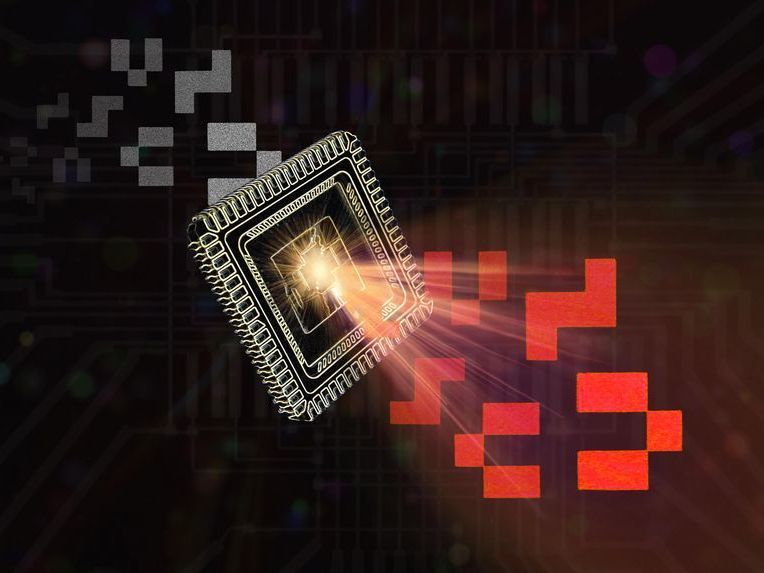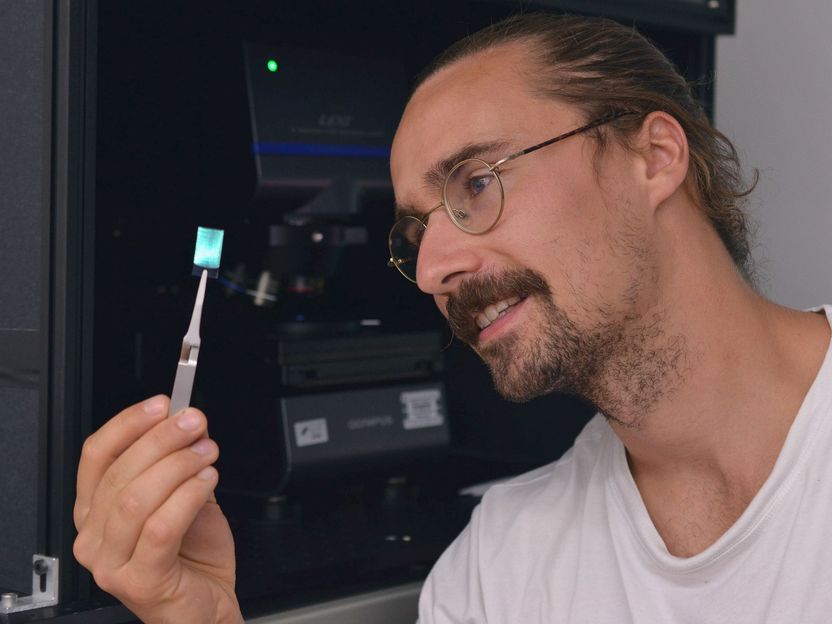Neural Hardware for Image Recognition in Nanoseconds
Ultra-fast image sensor with a built-in neural network can be trained to recognize certain objects
Automatic image recognition is widely used today: There are computer programs that can reliably diagnose skin cancer, navigate self-driving cars, or control robots. Up to now, all this has been based on the evaluation of image data as delivered by normal cameras - and that is time-consuming. Especially when the number of images recorded per second is high, a large volume of data is generated that can hardly be handled.

A picture is analyzed by the chip, which then provides the appropriate output signal.
Joanna Symonowicz, TU Wien
Scientists at TU Wien therefore took a different approach: using a special 2D material, an image sensor was developed that can be trained to recognize certain objects. The chip represents an artificial neural network capable of learning. The data does not have to be read out and processed by a computer, but the chip itself provides information about what it is currently seeing - within nanoseconds. The work has now been presented in the scientific journal "Nature".
Learning Hardware
Neural networks are artificial systems that are similar to our brain: Nerve cells are connected to many other nerve cells. When one cell is active, this can influence the activity of neighbouring nerve cells. Artificial learning on the computer works according to exactly the same principle: A network of neurons is simulated digitally, and the strength with which one node of this network influences the other is changed until the network shows the desired behaviour.
"Typically, the image data is first read out pixel by pixel and then processed on the computer," says Thomas Mueller. "We, on the other hand, integrate the neural network with its artificial intelligence directly into the hardware of the image sensor. This makes object recognition many orders of magnitude faster."
The chip was developed and manufactured at the TU Vienna. It is based on photodetectors made of tungsten diselenide - an ultra-thin material consisting of only three atomic layers. The individual photodetectors, the "pixels" of the camera system, are all connected to a small number of output elements that provide the result of object recognition.
Learning through variable sensitivity
"In our chip, we can specifically adjust the sensitivity of each individual detector element - in other words, we can control the way the signal picked up by a particular detector affects the output signal," says Lukas Mennel, first author of the publication. "All we have to do is simply adjust a local electric field directly at the photodetector." This adaptation is done externally, with the help of a computer program. One can, for example, use the sensor to record different letters and change the sensitivities of the individual pixels step by step until a certain letter always leads exactly to a corresponding output signal. This is how the neural network in the chip is configured – making some connections in the network stronger and others weaker.
Once this learning process is complete, the computer is no longer needed. The neural network can now work alone. If a certain letter is presented to the sensor, it generates the trained output signal within 50 nanoseconds - for example, a numerical code representing the letter that the chip has just recognized.
Object detection when things have to go fast
"Our test chip is still small at the moment, but you can easily scale up the technology depending on the task you want to solve," says Thomas Mueller. "In principle, the chip could also be trained to distinguish apples from bananas, but we see its use more in scientific experiments or other specialized applications.”
The technology can be usefully applied wherever extremely high speed is required: "From fracture mechanics to particle detection - in many research areas, short events are investigated," says Thomas Mueller. "Often it is not necessary to keep all the data about this event, but rather to answer a very specific question: Does a crack propagate from left to right? Which of several possible particles has just passed by? This is exactly what our technology is good for."
Original publication
Other news from the department science
Most read news
More news from our other portals
See the theme worlds for related content
Topic world Sensor technology
Sensor technology has revolutionized the chemical industry by providing accurate, timely and reliable data across a wide range of processes. From monitoring critical parameters in production lines to early detection of potential malfunctions or hazards, sensors are the silent sentinels that ensure quality, efficiency and safety.

Topic world Sensor technology
Sensor technology has revolutionized the chemical industry by providing accurate, timely and reliable data across a wide range of processes. From monitoring critical parameters in production lines to early detection of potential malfunctions or hazards, sensors are the silent sentinels that ensure quality, efficiency and safety.






























































